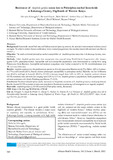| dc.contributor.author | Kitungulu, Nicholas | |
| dc.contributor.author | Guyah, Bernard | |
| dc.contributor.author | Webale, Mark | |
| dc.contributor.author | Shaviya, Nathan | |
| dc.contributor.author | Machani, Maxwell | |
| dc.contributor.author | Mulama, David | |
| dc.contributor.author | Ndenga, Bryson | |
| dc.date.accessioned | 2022-05-18T07:28:40Z | |
| dc.date.available | 2022-05-18T07:28:40Z | |
| dc.date.issued | 2022-04-29 | |
| dc.identifier.uri | https://dx.doi. org/10.4314/ahs.v22i1.68 | |
| dc.identifier.uri | https://www.ajol.info/index.php/ahs/article/view/224685 | |
| dc.identifier.uri | http://ir-library.mmust.ac.ke:8080/xmlui/handle/123456789/2049 | |
| dc.description.abstract | Background: Insecticide treated bed nets and Indoor residual spraying remains the principal interventional malaria control strategies. To achieve malaria disease eradication, vector control programmes that monitor insecticide resistance profiles are necessary.
Objective: The study evaluated pirimiphos-methyl susceptibility of Anopheles gambiae sensu lato in Kakamega County, western Kenya.
Methods: Adult Anopheles gambiae sensu lato mosquitoes were assayed using World Health Organization tube bioassay against 0.25% pirimiphos-methyl. Susceptible and non-susceptible populations were characterized to species-level using Polymerase Chain Reaction. Susceptible and resistant mosquitoes were further subjected to G119S Acetylcholisterase (ace 1R) mutation detection.
Results: Anopheles arabiensis was the predominant species in all study population Mumias east (62%), Malava (68%), Ikolomani (77%) and Lurambi (82%). Results showed phenotypic susceptibility to pirimiphos-methyl. Mortality was low in Mumias east (80.6%) and high in Lurambi (89.0%). G119S mutations ranged from 3.0% to 8.9% in Anopheles arabiensis whereas G119S mutations were relatively low ranging from 0.0% to 3.1% in Anopheles gambiae s.s populations. Study populations tested were consistent with Hardy-Weinberg equilibrium (P>0.05).
Conclusion: We observed pirimiphos-methyl resistance in Anopheles arabiensis and Anopheles gambiae s.s. study populations. Results showed G119S mutation in resistance population. Resistance monitoring and management are urgently required. | en_US |
| dc.language.iso | en | en_US |
| dc.publisher | African Health Sciences | en_US |
| dc.subject | Resistance, Anopheles, gambiae, sensu lato, Pirimiphos-methyl, Insecticide ,County, Highlands | en_US |
| dc.title | Resistance of Anopheles gambiae sensu lato to Pirimiphos-methyl Insecticide in Kakamega County, Highlands of Western Kenya | en_US |
| dc.type | Article | en_US |

